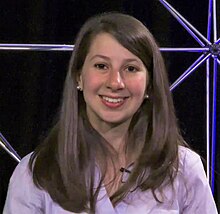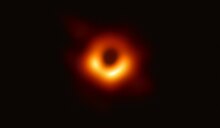Katie Bouman
Katie Bouman | |
|---|---|
 Katie Bouman en 2019. | |
| Born | 9 May 1989 |
| Alma mater | |
| Parent(s) | |
| Awards |
|
| Website | www |
| Academic career | |
| Fields | Computer vision, machine learning |
| Institutions |
|
| Thesis | Extreme imaging via physical model inversion : seeing around corners and imaging black holes |
| Doctoral advisor | William T. Freeman |
Katherine Louise Bouman (/ˈbaʊmæn/;[1] born 1989 or 1990)[2] is an American computer scientist working in the field of imaging. She was a member of the Event Horizon Telescope team that captured the first image of a black hole.[3][4] She is expected to join the faculty of California Institute of Technology in June 2019 as an assistant professor of computing and mathematical sciences.[5]
Early life and education
Bouman grew up in West Lafayette, Indiana, and graduated from West Lafayette Junior-Senior High School in 2007. Her father, Charles Bouman, is a professor of electrical and computer engineering and biomedical engineering at Purdue University.[6] As a high school student, she conducted imaging research at Purdue University.[6] She first learned about the Event Horizon Telescope in school in 2007.[7]
Bouman studied electrical engineering at the University of Michigan and graduated summa cum laude in 2011. She earned her master's degree (2013) and doctoral degree (2017) in electrical engineering and computer science from the Massachusetts Institute of Technology (MIT).[8]
| External videos | |
|---|---|
At MIT, she was a member of the Haystack Observatory.[9] She was supported by a National Science Foundation Graduate Fellowship. Her master's thesis, Estimating Material Properties of Fabric through the Observation of Motion,[10] was awarded the Ernst Guillemin Award for best Master's Thesis.[11] Her Ph.D. dissertation, Extreme imaging via physical model inversion: seeing around corners and imaging black holes, was supervised by William T. Freeman.[12] Prior to receiving her doctoral degree, Bouman delivered a TEDx talk, How to Take a Picture of a Black Hole, which explained algorithms that could be used to capture the first image of a black hole.[1][13]
Research and career
After earning her doctorate, Bouman joined Harvard University as a postdoctoral fellow on the Event Horizon Telescope Imaging team.[14][15][16] She will join the California Institute of Technology as an assistant professor in June 2019, where she plans to work on new systems for computational imaging using computer vision and machine learning.[17][18][19]

Bouman led the development of an algorithm for imaging black holes, known as Continuous High-resolution Image Reconstruction using Patch priors, or CHIRP.[20][13][21] CHIRP inspired image validation procedures used in acquiring the first image of a black hole in April 2019,[22] and Bouman played a significant role in the project[3][23] by verifying images, selecting parameters for filtering images taken by the Event Horizon Telescope[24] and participating in the development of a robust imaging framework that compared the results of different image reconstruction techniques.[25] Her group is analyzing the Event Horizon Telescope's images to learn more about general relativity in a strong gravitational field.[18]
After publication of the black hole image, a photo of Bouman smiling in front of a computer screen appeared widely in news outlets and social media,[3][26][27][28] where Bouman's contribution was hailed as a symbol of women's accomplishments in science, technology, engineering, and mathematics.[3] Controversy then ensued over whether the role Bouman played was overstated by the media.[3] Bouman became subject to harassment online, to the extent that her colleague Andrew Chael made a statement on Twitter criticizing "awful and sexist attacks on my colleague and friend Katie Bouman", including attempts to undermine her contributions by crediting him solely with the work in fact accomplished by a team that included Bouman, Chael, and numerous others.[23][25][29][30]
References
- ^ a b c Bouman, Katie. "Katie Bouman | Speaker | TED". www.ted.com. Retrieved April 10, 2019.
- ^ Guarino, Ben (April 10, 2019). "Algorithms gave us the black hole picture. She's the 29-year-old scientist who helped create them". The Washington Post. Retrieved April 16, 2019.
- ^ a b c d e Mervosh, Sarah (April 11, 2019). "How Katie Bouman Accidentally Became the Face of the Black Hole Project". The New York Times. Retrieved April 12, 2019.
- ^ Anon (April 11, 2019). "The woman behind first black hole image". bbc.co.uk. BBC News.
- ^ "Katie Bouman Joins EAS and CMS". cms.caltech.edu. Retrieved April 11, 2019.
- ^ a b Bangert, Dave (April 10, 2019). "That first-ever black hole picture? A West Lafayette grad played a big part". conline.com. Journal & Courier. Retrieved April 10, 2019.
- ^ Abraham, Zennie (April 10, 2019). "About Katie Bouman Creator Of First Black Hole Image From Event Horizon Telescope". oaklandnewsnow.com. Oakland News Now Today. Retrieved April 10, 2019.
- ^ "Katie Bouman aka Katherine L. Bouman". people.csail.mit.edu. Retrieved April 11, 2019.
- ^ "Working together as a "virtual telescope," observatories around the world produce first direct images of a black hole". news.mit.edu. MIT News. Retrieved April 10, 2019.
- ^ Bouman, Katherine Louise (2013). Estimating the material properties of fabric through the observation of motion (S.M. thesis). Massachusetts Institute of Technology. hdl:1721.1/84905. OCLC 868903611.

- ^ "EECS Celebrates – Fall 2014 Awards | MIT EECS". www.eecs.mit.edu. Retrieved April 10, 2019.
- ^ Bouman, Katherine Louise (2017). Extreme imaging via physical model inversion : seeing around corners and imaging black holes (PhD thesis). Massachusetts Institute of Technology. hdl:1721.1/113998. OCLC 1027411179.

- ^ a b Chappel, Bill (April 10, 2019). "Earth Sees First Image Of A Black Hole". NPR. Retrieved April 10, 2019.
- ^ "Katie Bouman". bhi.fas.harvard.edu. Retrieved April 10, 2019.
- ^ "Professor Katie Bouman (Caltech): " Imaging a Black Hole with the Event Horizon Telescope"". Retrieved April 10, 2019.
- ^ "Project bids to make black hole movies". BBC News. Retrieved April 10, 2019.
- ^ Katie Bouman publications indexed by Google Scholar
- ^ a b "Katherine L. (Katie) Bouman". caltech.edu. California Institute of Technology. Retrieved April 10, 2019.
- ^ "Imaging the Invisible". www.ee.columbia.edu. Retrieved April 10, 2019.
- ^ Bouman, Katherine L.; Johnson, Michael D.; Zoran, Daniel; Fish, Vincent L.; Doeleman, Sheperd S.; Freeman, William T. (2016). "Computational Imaging for VLBI Image Reconstruction": 913–922. arXiv:1512.01413. doi:10.1109/CVPR.2016.105. hdl:1721.1/103077.
{{cite journal}}: Cite journal requires|journal=(help) - ^ "Scientist superstar Katie Bouman designed algorithm for black hole image". phys.org. Retrieved April 12, 2019.
- ^ @MIT_CSAIL (April 12, 2019). "Clarification" (Tweet) – via Twitter.
- ^ a b Elfrink, Tim. "Trolls hijacked a scientist's image to attack Katie Bouman. They picked the wrong astrophysicist". Washington Post. Retrieved April 12, 2019.
{{cite web}}: Cite has empty unknown parameters:|1=and|dead-url=(help) (alternate source) - ^ Lou, Michelle; Ahmed, Saeed (April 10, 2019). "That image of a black hole you saw everywhere today? Thank this grad student for making it possible". cnn.com. CNN. Retrieved April 10, 2019.
- ^ a b Chael, Andrew. "…With a few others, Katie also developed the imaging framework that rigorously tested all three codes and shaped the entire paper". Twitter.
- ^ Ellis-Petersen, Hannah (April 11, 2019). "Katie Bouman: the 29-year-old whose work led to first black hole photo". The Guardian. Retrieved April 13, 2019.
- ^ Lou, Michelle; Ahmed, Saeed (April 12, 2019). "To undermine Katherine Bouman's role in the black hole photo, trolls held up a white man as the real hero — until he fought back". CNN. Retrieved April 13, 2019.
- ^ Collins, Ben (April 12, 2019). "The first picture of a black hole made Katie Bouman an overnight celebrity. Then internet trolls descended". NBC News. Retrieved April 13, 2019.
- ^ Griggs, Mary Beth (April 13, 2019). "Online trolls are harassing a scientist who helped take the first picture of a black hole". The Verge. Retrieved April 14, 2019.
- ^ Joyce, Kathleen (April 13, 2019). "Internet trolls attempted to discredit Katie Bouman's work on black hole project". Fox News. Retrieved April 14, 2019.
